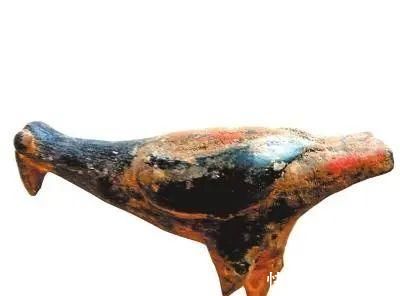城址$双语说河南|在中原 追寻夏的轨迹( 三 )
古城寨地近夏人活动的中心地区,是新石器时代晚期文化与夏文化分界的重要标志之一。特别是城垣与大型建筑(宫庙)基址的发现,为二里头文化宫殿基址找到了源头,也为郑州商代宫殿基址坐落城东北部的布局开了先河。揭示了夏商文明的基本特征,成为研究我国古代文明形成、国家产生的重要佐证。上个世纪八十年代,这里曾被命名为郐国故城。通过后来持续的考古调查,又发现这个城址的年代应该比郐国故城更早,该城址各种文化错综复杂,但仍是以龙山文化遗存为主。
Major discoveries include palace buildings, city walls and sacrificial pits.
重要遗迹遗物:宫殿遗址、古城墙、祭祀坑。

文章插图
The Xinzhai Site in Xinmi: The First Capital of the Xia Dynasty?
新密新砦遗址:夏朝开国都城是它吗
As for the origin and formation of ancient Chinese civilization, the mainstream has been formed that the Erlitou Culture (around 1735 BC-1530 BC) is of the Xia Dynasty, but the questions have not been resolved such as "What is the culture of the early Xia Dynasty?" and "Are there any cultures earlier than the Erlitou Culture?" From 1999 to 2000, the Center for Ancient Civilization Studies of Peking University and the Institute of Cultural Relics and Archaeology of Zhengzhou jointly lunched a new excavation at the Xinzhai Site, and one of the most important findings is that they discovered the stacked remains of the third stage of the Wangwan Culture (after 2400 BC or so), the Xinzhai Phase (around 1870 BC-1720 BC) and the early stage of the Erlitou Culture. Besides, thousands of cultural relics were unearthed, more than 300 of which have been restored. Finally, sufficient evidence points to the existence of the Xinzhai Phase. Nowadays, basically the Xinzhai Phase has been confirmed to be of the Xia Dynasty, even earlier than the Erlitou Culture, which is of great significance to search for the capital ruins of the early Xia Dynasty, study its establishment and probe into the origin of ancient Chinese civilization.
近年来在探讨中国古代文明的起源与形成这一重大学术课题时,二里头文化是夏文化已经成为主流认识。但对于何为早期夏文化,有没有比二里头文化更早的夏文化等问题,学界看法不一。1999-2000年,北京大学古代文明研究中心和郑州市文物考古研究所联合对新砦遗址重新进行发掘。其重要收获是发掘出王湾三期文化、新砦期遗存和二里头文化早期遗存的三叠层,并出土各类器物数千件,其中复原陶器达300余件。最终,从大量的地层关系、器物形制演变、碳十四测年数据等多方面,证明“新砦期”的确存在。是比著名的二里头文化还要早的夏文化。它对于寻找早期夏都遗址、探讨夏王朝的诞生以及中国古代文明的起源,都具有十分重要的意义。
Some experts pointed out that the Xinzhai Site was the capital city of the king Qi. 84.87 percent of the carbonized seeds unearthed from the Xinzhai Site are of crops, including millet, glutinous millet, unhusked rice, soybeans and wheat, sorted from the most to the least, indicating that during the Xinzhai Phase, bumper harvests had been realized. Besides, one of the prominent features of the Xinzhai Phase lies in its oriental culture, indicating the truth of the story about Dongyi (an ancient tribe in ancient East China) invading the Xia Dynasty, to some extent.
有专家认为,新砦遗址极有可能是中国考古界苦苦寻找多年的夏代开国之君夏启的都城。考古发掘表明,在新砦遗址,发现了粟、黍、稻谷、大豆、小麦。“五谷丰登”的局面初步形成。此外,新砦期还发现了诸多东方文化因素,说明文献记载的“东夷乱夏”可能是真实存在。
Major discoveries include the remains of the Xinzhai Phase, a 3,800-year-old red pottery bird statue, etc.
- 小说$6本男主假高冷小说,强推《镇河》好好笑,作者脑洞未免也太大了
- 王之心&四本开局就惊艳读者的小说,一看书名就想入坑,书荒的你值得拥有
- 船夫&新科状元乘船回家,船夫随口说出一上联,状元却至死都没对出来
- 热血小说$15年老书虫推荐3本百看不厌的热血小说,值得你通宵达旦看完啊!
- 梁炎东!3部强逻辑悬疑小说,人间修罗案神乎其神,谁能戳破鬼怪谣言?
- |茅奖小说《暗算》出版20年,精装版归来继续密码和人心全解密
- 逍遥小书生!五本不输《赘婿》的架空历史小说,评分高达9.5!全部都是精品
- 方腊#鲁智深生擒方腊后说了2句话,共6个好汉听懂了,离开宋江得善终
- 进化&碾压《诡秘之主》,反超《牧神记》,辰东这本小说爆红逆袭登顶
- 帕子@《我的前夫是宦官》当我的丈夫是个宦官,我和他不得不说的故事!
